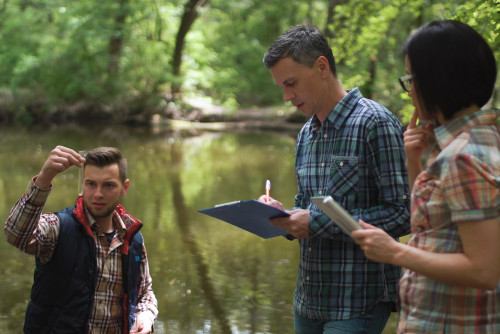Physics AS-T Degree
Provides students with the opportunity to meet the requirements for transfer to the CSU system in Physics or a similar major.
Associate in Science for Transfer | SC Program: AS-T.1004
Majoring in the physical sciences is great preparation for almost any career, because they teach students how to analyze complex problems and give students a strong quantitative background that can be applied to any technical field.
The Associate in Science in Physics for Transfer Degree (AS-T in Physics) provides students with the opportunity to meet the requirements for transfer to the California State University system in Physics or a similar major. In order to earn this degree a student must complete 60 required semester units of CSU transferable coursework with a minimum GPA of 2.0. Completing this degree guarantees admission to the CSU system but not to a particular campus or major. The degree is designed to prepare students for upper division study in Physics and related fields.
Physics graduates at the bachelor’s level are qualified for employment by industry or government in a variety of technical positions. They also frequently enter graduate programs to pursue advanced degrees in Physics or related fields. Physics graduates are often well qualified for admission into professional programs in medicine or law. Those students interested in teaching at the high school level should know that the nation is experiencing a shortage of well qualified physics teachers. Current and prospective community college students interested in this degree are encouraged to meet with a Counselor to develop an educational plan that best meets their goals and needs.



Choose your path
Map your education by viewing the program map for the degree or certificate you’re interested in earning below. Meet with a counselor to create your official comprehensive education plan.
A program map shows all the required and recommended courses you need to graduate and a suggested order in which you should take them. The suggested sequence of courses is based on enrollment and includes all major and general education courses required for the degree.
Fall Semester, First Year
16 Units TotalFirst semester of a four-semester sequence covering differentiation of single variable functions, applications of the derivative, introduction to integration, and introduction to differential equations. This course may be offered in a distance education format.
This course is a survey of the history of the United States from Pre-Columbian Peoples to the end of Reconstruction. Topics include contact and settlement of America, the movement toward independence, the formation of a new nation and Constitution, westward expansion and manifest destiny, the causes and consequences of the Civil War, and Reconstruction. This course satisfies the CSU requirement for US History (US-1). This course may be offered in a distance education format.
Spring Semester, First Year
15 Units TotalThe fundamental principles of mechanics are treated within the mathematical framework of elementary differential and integral calculus. Vectors, Newton's Laws, work, energy gravitation, linear and angular momentum, rotational dynamics and motion studies are discussed.
Techniques of integration, including substitution, integration by parts and partial fractions. Improper integrals. Applications of integration to geometry and physics: finding areas, volumes and arclength, work, center of mass and fluid force. Sequences, series, absolute convergence and convergence tests, power series and Taylor and MacLaurin series. First-order ordinary differential equations and linear second-order differential equations. This course may be offered in a distance education format.
Fall Semester, Second Year
14 Units TotalAn introduction to United States and California government and politics, including their constitutions, political institutions and processes, and political actors. Examination of political behavior, political issues, and public policy. This course satisfies the CSU requirement in U.S. Constitution and California State and local government (US-2 and US-3). This course may be offered in a distance education format.
This course covers vectors in two and three dimensions, multi-variable functions, partial differentiation, multiple integrals, line integrals, divergence, gradient, curl, Stokes' Theorem, Divergence Theorem, and Green's Theorem. This course may be offered in a distance education format.
Spring Semester, Second Year
17 Units TotalThis course is a comparative survey of the major ancient world civilizations which developed between 3500 B.C.E. and 1500 C.E. It examines political institutions, religious ideologies, the rise and fall of empires, and the major cultural innovations of each of the major world civilizations. This course may be offered in a distance education format.
This course takes an interdisciplinary approach to the study of race and ethnicity in the United States. It examines social justice movements in relation to ethnic and racial groups in the United States to provide a basis for a better understanding of the socioeconomic, cultural, and political conditions among key social groups including, but not limited to, Native Americans, African Americans, Asian Americans, and Latina/o Americans. This course examines the systemic nature of racial/ethnic oppression through an examination of key concepts including racialization and ethnocentrism, with a specific focus on the persistence of white supremacy. Using an anti-racist framework, the course will examine historical and contemporary social movements dedicated to the decolonization of social institutions, resistance, and social justice. This course may be offered in a distance education format.
A course in ordinary differential equations covering first and second order differential equations, with applications; Laplace transforms; series solutions at an ordinary point; matrices and linear algebra; and systems of linear differential equations.
The third in a three-course sequence, this course covers general properties of waves, electromagnetic waves, reflection and refraction, interference and diffraction, the special theory of relativity, the quantum nature of light and the wave nature of matter, and Schrodinger's equation.
Please see a counselor to discuss options for meeting general education requirements for transfer to California State Universities (CSU) and/or University of California (UC) campuses, as well as any specific additional courses that may be required by your chosen institution of transfer.
*Alternative Courses: Please see a Shasta College counselor for alternative course options. You can also view the following to find other courses to meet degree/certificate requirements:
- California State Universities – General Education
- IGETC – Intersegmental General Education Transfer Curriculum
Need a print out? Feel free to download and/or print out a copy of the sample program map(s).
Contact Us for More Information
Counseling & Student Services
Contact InfoAcademic/Instructional Division Office
Science, Language Arts & Mathematics (SLAM)
Contact InfoStart Your Future at Shasta College
We are dedicated to helping you reach your educational and career goals. To begin your journey, apply for admissions today!

